Published
on 7
Oct 2010
|
All rights reserved.
|
|
|
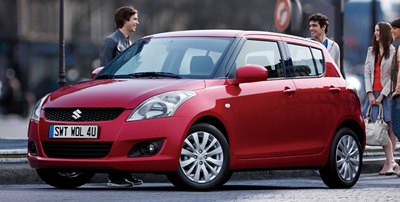
|
All-new Swift makes little difference
|
The Suzuki Swift shown here
seems like a minor facelift of the outgoing car. Compare with that car,
its nose is a little rounder, its headlights a little sharper and, in
5-door form, the rear side windows a little less rectangular – more
like the old 3-door. Gentle curves have been introduced to the lower
part of its doors. In fact, behind these subtle styling tweaks is
actually an all-new generation Swift. Surprise ?
Yes, I notice many car makers now claim "all-new generation" to what we
used to call "facelift". For instance, the latest Volkswagen Golf and
Passat are doing updates in this way. However, when you see Suzuki
Swift gets a wheelbase stretch of 50mm (from 2380 to 2430mm), you know
it is a true new generation, because this involves redesigning the
chassis hence considerable engineering cost. Apart from longer
wheelbase, the new Swift is also 90 mm longer overall, and runs
slightly wider tracks. More usage of high-strength steel improves its
crash worthiness as well as limiting the overall weight gain to 40 kg.
It is still smaller and lighter than most European superminis.
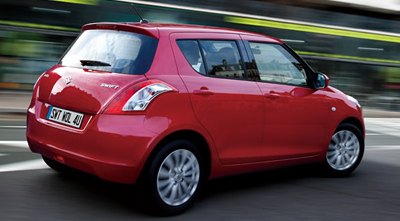
|
It is still a frill-free basic
transport for young people.
|
Just don't expect any innovative ideas
or fancy packaging. The new Swift follows the formula of the old car.
It is still a frill-free basic transport for young people. To keep
price low, its cabin is still trimmed with hard grey plastics, lacking
the quality feel of European alternatives. Unlike Honda Jazz, its rear
seats do no more than split fold, and the resultant load bay is
non-flat. Accommodation is okay for four regular size guys, whereas
luggage space biases towards the small side.
On the road, there is noticeable improvement in running refinement as
the chassis appears to be stiffer and the suspension isolates from big
bumps more effectively. It isn't as refined as the latest European
rivals though, because the suspension setup is still at the sporty
side. On the plus side, the Swift is pretty fun to drive if you are on
mood. It shows good body control, offers excellent grip and confident
braking. With the wheels located near the corners, it maneuvers with
remarkable stability. It's a pity that the electric steering is too
light and not very feelsome at the straight ahead position. Otherwise
the Swift would have been a good first car for young people to polish
their driving skill.
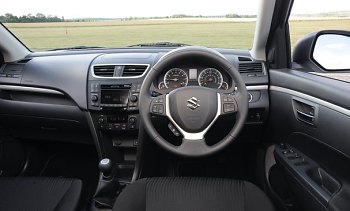
|
Cabin plastic still cheap; Refinement
improved.
|
In order to improve fuel economy and
emission, Suzuki replaced the old car's 1.3-liter engine with a new
1.2-liter unit, which comes with aluminum head and block, 11.0:1
compression and dual-continuous VVT. It is a sweet revving engine. 94
horsepower and 87 pound-foot of torque just eclipse the old engine's,
though peak torque now takes 4800 rpm to realize. On the road, this
peaky manner needs the driver to work hard on throttle and gearshift to
keep the engine boiling. This could be tiring in town or noisy on
highway. A light-pressure turbo could have solved its problems easily,
but it seems that Suzuki has no such plan.
Just as its appearance suggested, the new Swift is not radically
different from the old car. It still trades quality and refinement for
low price and sporty ride and handling. The world of superminis will be
more differentiated with this car, but I doubt if it can make an impact
to the market, whose trend is pursuing quality, versatility and
greenness. While it is a better car than before, it has not made enough
progress to stand the next 5 years or so.
|
Verdict:    |
| Published
on 4
Nov
2011 |
All rights reserved.
|
|
Swift Sport
|
|
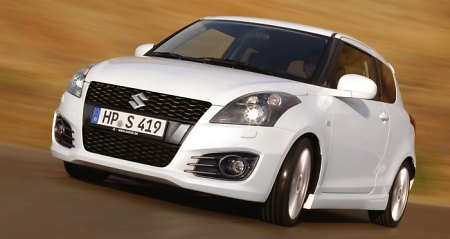
A turbocharged engine with
up to 200 horsepower, CO2-reducing
automatic engine stop-start, a quality interior, twin-clutch gearbox,
intelligent torque vectoring and adaptive dampers are becoming the
norms of small hot hatches. They certainly make the vehicle more
capable and practical, but also push up the price beyond the reach of
young enthusiastic drivers. Moreover, the chase for sophistication
usually comes at the price of driving fun. As we found out in many
cases, sophistication actually kills the raw excitement of driving a
car at full effort. This explains why Peugeot 205GTi is still widely
regarded as the greatest hot hatch ever made.
Suzuki Swift Sport is no 205GTi, of course, but we should praise its
courage to resist the industrial trend and follow the old-school way of
making hot hatches. Its exterior and interior remain honest, without
the over-decoration found on many rivals. Its engine remains the same
fast-revving M16A 1.6-liter engine as the 2005 model, just modified
with higher valve lift, revised variable inlet valve timing (still
absent on the exhaust side) and the addition of variable-length intake
manifolds to make another 10 horsepower and 9 pound-foot more torque. A
total of 134 hp and 118 lbft are modest for a hot hatch these days, so
its manual gearbox gets upgraded from 5 to 6 closely stacked ratios to
help squeezing the most from the little motor while lowering fuel
consumption by 11 percent by means of a higher 6th. The gearbox also
gets triple-cone synchromesh at 1st and 2nd gear to ensure light and
slick gearchanges.
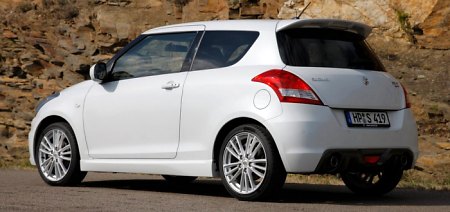
The chassis tuning is old-school, too. Stiffer suspension springs and
bushings tighten body control while sharpening steering response. Each
of the new alloy wheels is nearly 1 kg lighter than the old one,
compensating for the stiffer suspension setup. But most indicative are
the tires: it resists the temptation to opt for wider rubbers and
retains the old car's 195/45VR17. No wonder the Swift Sport displays
excellent balance in the twisty. It is one of the few hot hatches
remaining capable of lift-off oversteer in the real world. You don't
need to find a race track and absurd speed to overcome its grip. Just
find any back roads with which you are familiar and you can enjoy an
interactive handling. The motor is equally positive. It begs you to
keep it revving beyond 4500 rpm – the closer to the 7000 rpm redline
the better – and rewards you with a throaty soundtrack, if not quite
the absolute power.
Compare with the old car, the new Swift Sport gets more matured. Its
6th gear makes motorway cruising far less noisy. Its stiffer chassis
and suspensions lead to markedly less body roll and a more progressive
oversteer yet, thankfully, without hurting ride comfort. Thanks to a
more rigid mounting of the steering mechanism, the steering is more
precise and refined. Moreover, the steering is communicative, a rare
success for small cars these days.
However, the little Suzuki is not perfect. It could have been better
with a more powerful 1.8-liter or 2-liter engine like Renault Clio RS.
Its interior could be more special. Its exterior design could be more
stylish. But all these requirements might work against the philosophy
of this car, that is, an affordable, no-frill hot hatch that focuses on
pure driving excitement. We are grateful that Suzuki has not forgotten
what made hot hatches great.
|
Verdict:     |
|